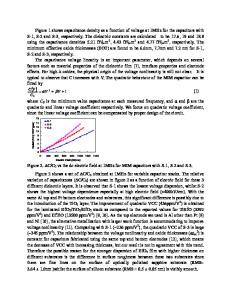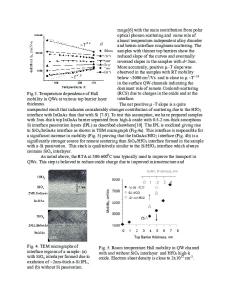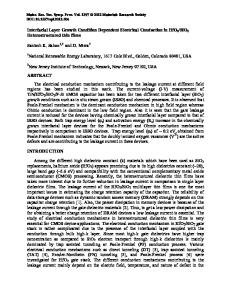Binary HfO 2 :SiO 2 used as High-k Gate Oxide in Combinatorial Material Library Method
- PDF / 171,846 Bytes
- 6 Pages / 612 x 792 pts (letter) Page_size
- 40 Downloads / 278 Views
0894-LL03-30.1
Binary HfO2:SiO2 used as High-k Gate Oxide in Combinatorial Material Library Method Wen-Hsuan Chao, Lih-Ping Wang, Shu-Huei Wang, T-H Huang, R-J Wu, Hung-Chiao Cheng Union Chemical Laboratories, Industrial Technology Research Institute, Hsinchu, Taiwan 310, R.O.C. ABSTRACT Hafnium silicates (HfO2:SiO2, HSO) have recently attracted much interest in the fields of fundamental science and technology because they have high dielectric constant and low leakage current. The structure and properties of HSO gate oxides were studied using a combinatorial continuous-compositional-spread method. HSO material libraries were synthesized on a 4-inch wafer at room temperature and at 200°C using a custom-built radio-frequency (RF) sputtering system. The electrical properties of HSO material libraries were measured using metal-oxidesemiconductor structure. X-ray diffraction (XRD) was utilized to characterize the structure and compositions of HSO material libraries. The effects of sputtering conditions on the properties of the HSO gate oxides were investigated. The dielectrics constants (εr ) of HSO material libraries treated with rapid thermal annealing (600°C/1min/N2) were in the range 5~23, as determined by C-V measurement, and the dielectric constant was observed to increase with HfO2 content. The I-V relations of the HSO material libraries indicate that the leakage current decreases as the amount of Si in the HSO films increases. The structural characteristics of HSO films with RTA treatment (1000°C/10sec/N2) varied from the amorphous to the crystalline state (tetragonal and monoclinic phase), according to the composition of material libraries. The correlation among the electrical properties, the composition and the crystal structure of the HSO films is discussed. INTRODUCTION An SiO2 gate oxide film has a fundamental limiting size of 1.5-1.8nm, below which the leakage current becomes seriously problematic [1]. Conventional SiO2 thin films should be smaller than 1nm for use in next generation ULSI, but a nm-scale SiO2 thin film suffers fromincreased leakage current and cannot be used because of its large power dissipation. Therefore, the substitution of SiO2 for high-k materials to form gate dielectrics is becoming increasingly important. The candidates for the next generation of gate oxides [2], which are in indirect contact with Si channels, must have a high dielectric constant to reduce the thickness of the gate insulation film and tackle the leakage current problem. Various high-k materials have
0894-LL03-30.2
been examined for potential integration with standard CMOS technology. HfO2 (εr ~25) and ZrO2 are known for their good thermal stability on a silicon surface and have similar interfacial properties to those of SiO2 [3], which a candidate for use in high-k gate dielectric applications. Also, HSO has recently attracted much fundamental scientific and technological interest because of its high dielectric constant and low leakage current [4-9]. The structure and properties of HSO gate oxides were investiga
Data Loading...











